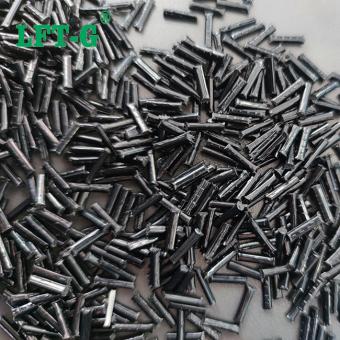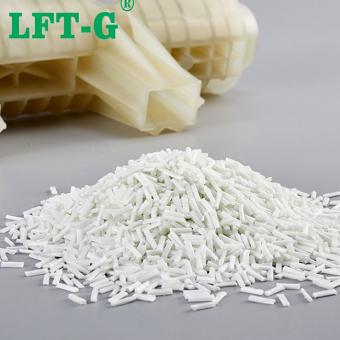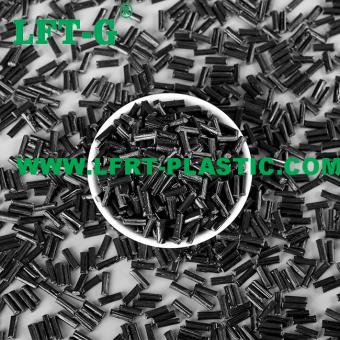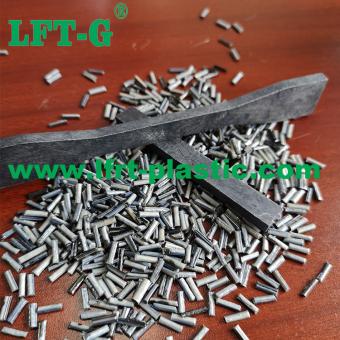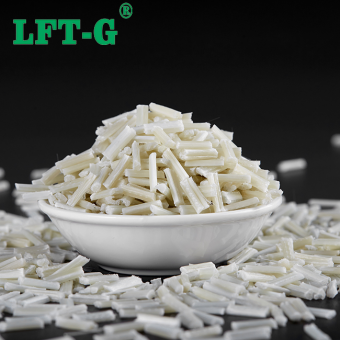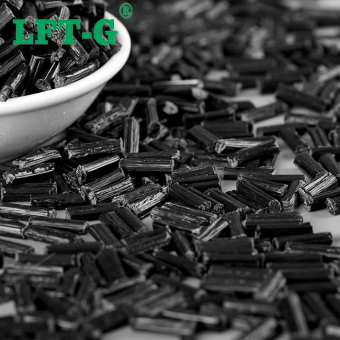-
LFT-G PP long carbon fiber reinforced material high performance original blackLong Carbon Fiber In recent years, due to the growing demand for lightweight in various industries around the world (automotive, aerospace, military, building and civil engineering, etc.), and the increasingly strict requirements for the use of environmentally friendly and sustainable materials, the use of fiber reinforced thermoplastic composites in various industries has been increasing. Especially for carbon fiber reinforced composites, there is still a high recycling value after the products are discarded after completing their life cycle, and through effective recycling technology and methods, the cost of carbon fiber reinforced composites can be significantly reduced. The recovery method of fiber reinforced thermoplastic composites is closely related to the shape and forming method of fiber reinforced in resin. Take carbon fiber reinforced thermoplastic composites as an example. The reinforced forms of carbon fiber mainly include short fiber reinforced, long fiber reinforced and continuous fiber reinforced, and the main preparation method is melt forming. For thermoplastic resins with high melting point, such as polyetherimide (PEI) and polyetherether ketone (PEEK), solvent forming can be adopted. Due to the linear molecular structure of thermoplastic resin, it is easy to transform from solid state to liquid state at high temperature. Therefore, thermoplastic composite materials can be recycled by remelting and reshaping method, which is more recyclable than thermosetting resin matrix composite materials. PP-LCF datasheet Application Our materails all can be recycled At present, more and more companies are developing recycling methods for fiber reinforced thermoplastic composites. For example, the 2014 Chevrolet Corvette uses composite materials containing recycled carbon fiber in 21 body panel components, including doors, boot LIDS, side coops and fenders. Ford Motor Company has used recycled long carbon fiber and polypropylene (LCF/PP) composites to replace the original ASA engineering plastic as the rigid part of the A-pillar bracket in its 2018 Explorer sport utility SUV. About LFT-G Xiamen LFT composite plastic Co., Ltd. is a brand-name company that focuses on LFR&LFRT. Long Glass Fiber Series (LGF) & Long Carbon Fiber Series (LCF). The company's thermoplastic LFT can be used for LFT-G injection molding and extrusion, and can also be used for LFT-D molding. It can be produced according to customer requirements: 5~25mm length. The company's long-fiber continuous infiltration reinforced thermoplastics have passed ISO9001&16949 system certification, and the products have obtained lots of national trademarks and patents. In particular, the carbon fiber LFT series produced by our company has broken the technical blockade of foreign countries. For domestic: automotive, military parts, firearms, aerospace, new energy, medical equipment, electric wind energy, sports equipment and other fields require high-performance thermoplastic special engineering plastics. And other new technology innovation industries provide product and technical support.
- PP resin lcf
- PP raw material of lcf
- 30% of lcf pp
- long carbon fiber filling plastic
- polypropylene composite plastic
- injection grade lcf
Tags :
-
Xiamen LFT-G PLA Polylactic acid composite long glass fiber filling thermoplastic resin original colorPLA PLA (polylactic acid) is also known as polylactic acid, the production process of polylactic acid is pollution-free, and the product can be biodegradable to achieve recycling in nature, so it is an ideal green polymer material, and one of the representatives of biodegradable plastics. The structure of PLA has important influence on its heat resistance, toughness, mechanical strength, degradability and biocompatibility. The influence on heat resistance is mainly discussed below. There is only one submethylene on the main chain of PLA molecule, the molecular chain has a spiral structure, and its activity is poor. As a result, the PLA after injection molding almost does not crystallize due to slow crystallization speed, so the heat resistance of the product is poor. During hot processing, the ester bond is partially broken to produce terminal carboxyl group, which plays an autocatalytic degradation effect on the thermal degradation of PLA. LGF reinforced PLA The rigidity of the fiber makes it play the role of skeleton support in the polymer matrix. When the polymer is heated, the movement of the chain segment is limited, thus improving the heat resistance of the material. At present, the fibers that can be used for enhancement modification of PLA include natural plant fiber (sisal, flax, linen, bamboo, coconut, wood fiber, etc.), natural animal fiber (silk, etc.), mineral fiber (basalt fiber, etc.), and chemical fiber (carbon fiber, glass fiber, etc.). Among these fibers, carbon fiber and glass fiber are widely used for their high strength and high modulus. Natural plant fiber has been widely studied because of its wide source, degradability and improved thermal and mechanical properties of composites. Modified natural fiber and modified inorganic fiber (glass fiber or carbon fiber) were mixed into the PLA matrix to prepare two kinds of fiber reinforced PLA composites. The test results show that the Vica softening temperature of the composites exceeds 140℃. Compared with Short fiber(SGF) Compared with the short fiber, it has more excellent performance in mechanical properties. It is more suitable for large products and structural parts. It has 1-3 times higher (toughness) than short fiber, and the tensile strength (strength and rigidity) is increased by 0.5-1 times. Injection molding Lab Warehouse Certification Xiamen LFT composite plastic Co., Ltd Xiamen LFT composite plastic Co., Ltd. is a brand-name company that focuses on LFT&LFRT. Long Glass Fiber Series (LGF) & Long Carbon Fiber Series (LCF). The company's thermoplastic LFT can be used for LFT-G injection molding and extrusion, and can also be used for LFT-D molding. It can be produced according to customer requirements: 5~25mm in length. The company's long-fiber continuous infiltration reinforced thermoplastics have passed ISO9001&16949 system certification, and the products have obtained lots of national trademarks and patents.
- PLA composite plastic can be recycled
- polyactic acid materials injection molding
- modified pla compounds
- pla long glass fiber reinforced plastic resin
- long glass fiber filling pla sample available
- lft-g pla lgf low warpage
Tags :
-
Xiamen LFT-G Polyphenyl sulfide filled 30% LCF PPS flame retardant grade UL-94 V0Polyphenylene sulfide is a new functional engineering plastic.
- Polyphenyl sulfide long carbon fibre
- PPS plastic rein forced compounds
- Composite material pps industrial use
- Filling lcf 30 pps composite plastic new materials
- High flame retardant car parts
- Factory use raw material modified plastic high performance
Tags :
-
LFT-G PLA Polylactic acid composite long glass fiber thermoplastic original colorPLA PLA (polylactic acid) is also known as polylactic acid, the production process of polylactic acid is pollution-free, and the product can be biodegradable to achieve recycling in nature, so it is an ideal green polymer material, and one of the representatives of biodegradable plastics. The structure of PLA has important influence on its heat resistance, toughness, mechanical strength, degradability and biocompatibility. The influence on heat resistance is mainly discussed below. There is only one submethylene on the main chain of PLA molecule, the molecular chain has a spiral structure, and its activity is poor. As a result, the PLA after injection molding almost does not crystallize due to slow crystallization speed, so the heat resistance of the product is poor. During hot processing, the ester bond is partially broken to produce terminal carboxyl group, which plays an autocatalytic degradation effect on the thermal degradation of PLA. LGF reinforced PLA The rigidity of the fiber makes it play the role of skeleton support in the polymer matrix. When the polymer is heated, the movement of the chain segment is limited, thus improving the heat resistance of the material. At present, the fibers that can be used for enhancement modification of PLA include natural plant fiber (sisal, flax, linen, bamboo, coconut, wood fiber, etc.), natural animal fiber (silk, etc.), mineral fiber (basalt fiber, etc.), and chemical fiber (carbon fiber, glass fiber, etc.). Among these fibers, carbon fiber and glass fiber are widely used for their high strength and high modulus. Natural plant fiber has been widely studied because of its wide source, degradability and improved thermal and mechanical properties of composites. Modified natural fiber and modified inorganic fiber (glass fiber or carbon fiber) were mixed into the PLA matrix to prepare two kinds of fiber reinforced PLA composites. The test results show that the Vica softening temperature of the composites exceeds 140℃. Compared with Short fiber(SGF) Compared with the short fiber, it has more excellent performance in mechanical properties. It is more suitable for large products and structural parts. It has 1-3 times higher (toughness) than short fiber, and the tensile strength (strength and rigidity) is increased by 0.5-1 times. Injection molding Lab Warehouse Certification Xiamen LFT composite plastic Co., Ltd Xiamen LFT composite plastic Co., Ltd. is a brand-name company that focuses on LFT&LFRT. Long Glass Fiber Series (LGF) & Long Carbon Fiber Series (LCF). The company's thermoplastic LFT can be used for LFT-G injection molding and extrusion, and can also be used for LFT-D molding. It can be produced according to customer requirements: 5~25mm in length. The company's long-fiber continuous infiltration reinforced thermoplastics have passed ISO9001&16949 system certification, and the products have obtained lots of national trademarks and patents.
- PLA composite plastic
- polyactic acid materials
- pla long glass fiber lgf
- long glass fiber filling pla
- lft-g pla lgf
Tags :
-
Xiamen LFT PP Polypropylene long carbon fiber reinforced thermoplastic resin for car partsLong Carbon Fiber In recent years, due to the growing demand for lightweight in various industries around the world (automotive, aerospace, military, building and civil engineering, etc.), and the increasingly strict requirements for the use of environmentally friendly and sustainable materials, the use of fiber reinforced thermoplastic composites in various industries has been increasing. Especially for carbon fiber reinforced composites, there is still a high recycling value after the products are discarded after completing their life cycle, and through effective recycling technology and methods, the cost of carbon fiber reinforced composites can be significantly reduced. The recovery method of fiber reinforced thermoplastic composites is closely related to the shape and forming method of fiber reinforced in resin. Take carbon fiber reinforced thermoplastic composites as an example. The reinforced forms of carbon fiber mainly include short fiber reinforced, long fiber reinforced and continuous fiber reinforced, and the main preparation method is melt forming. For thermoplastic resins with high melting point, such as polyetherimide (PEI) and polyetherether ketone (PEEK), solvent forming can be adopted. Due to the linear molecular structure of thermoplastic resin, it is easy to transform from solid state to liquid state at high temperature. Therefore, thermoplastic composite materials can be recycled by remelting and reshaping method, which is more recyclable than thermosetting resin matrix composite materials. PP-LCF datasheet Application Our materails all can be recycled At present, more and more companies are developing recycling methods for fiber reinforced thermoplastic composites. For example, the 2014 Chevrolet Corvette uses composite materials containing recycled carbon fiber in 21 body panel components, including doors, boot LIDS, side coops and fenders. Ford Motor Company has used recycled long carbon fiber and polypropylene (LCF/PP) composites to replace the original ASA engineering plastic as the rigid part of the A-pillar bracket in its 2018 Explorer sport utility SUV. About LFT-G Xiamen LFT composite plastic Co., Ltd. is a brand-name company that focuses on LFR&LFRT. Long Glass Fiber Series (LGF) & Long Carbon Fiber Series (LCF). The company's thermoplastic LFT can be used for LFT-G injection molding and extrusion, and can also be used for LFT-D molding. It can be produced according to customer requirements: 5~25mm length. The company's long-fiber continuous infiltration reinforced thermoplastics have passed ISO9001&16949 system certification, and the products have obtained lots of national trademarks and patents. In particular, the carbon fiber LFT series produced by our company has broken the technical blockade of foreign countries. For domestic: automotive, military parts, firearms, aerospace, new energy, medical equipment, electric wind energy, sports equipment and other fields require high-performance thermoplastic special engineering plastics. And other new technology innovation industries provide product and technical support.
- PP resin lcf automotive spare parts resin
- PP raw material of lcf instead metal lightweight
- 30% of lcf pp CFRP cf30 toughness PP
- injection grade lcf properties high
Tags :
-
LFT-G PEEK Polyether ether ketone composite long carbon fiber thermoplastic resinPEEK-LCF Polyether ether ketone (abbreviated PEEK) not only has excellent mechanical, heat and chemical resistance properties, and low friction coefficient, good bearing meshing, is another kind of good self-lubricating material after polytetrafluoroethylene (PTFE), in the bearing capacity and wear resistance than PTFE performance is better, In no lubrication, low speed and high load, high temperature, humidity, pollution, corrosion and other harsh environment is especially suitable. On this basis, the addition of carbon fiber not only enhances its mechanical properties, its friction performance has important influence. At room temperature, the tensile strength of 30% carbon fiber reinforced PEEK composite doubled, and reached three times at 150℃. At the same time, the impact strength, bending strength and modulus of the reinforced composite were also greatly improved, the elongation was sharply reduced, and the thermal deformation temperature could exceed 300℃. The impact energy absorption rate of the composite directly affects the impact performance of the composite. The carbon fiber reinforced PEEK composite shows a specific energy absorption capacity of up to 180kJ/kg. The reinforced effect of carbon fiber can also resist the thermal softening of PEEK and form a transfer film with very high strength to a certain extent, which can effectively protect the contact area. Therefore, the friction coefficient and specific wear rate of carbon fiber reinforced PEEK composite are significantly lower than that of pure PEEK. Under the same experimental conditions, the friction and wear resistance of carbon fiber reinforced PEEK composites is obviously better than that of glass fiber PEEK composites, and the improvement effect of carbon fiber on the wear resistance of materials is more than 5 times that of glass fiber with the same dosage. Carbon fiber reinforced PEEK composite material is used in parts manufacturing, which can effectively avoid the surface cracks of metal or ceramic materials, and its excellent tribological properties even exceed that of ultra-high molar mass polyethylene. TDS Application Long carbon fiber reinforced PEEK is mainly applied in the following four areas: 1. Electronic and electrical appliances PEEK can maintain good electrical insulation in the harsh environment such as high temperature, high pressure and high humidity, and has the characteristics of non-deformation in a wide temperature range, so it is used as an ideal electrical insulation material in the field of electronic and electrical appliances. The mechanical properties, chemical corrosion resistance, radiation resistance and high temperature resistance of polyether ether ketone reinforced by carbon fiber have been further improved, and its application fields have been further expanded. 2. Aerospace Polyether ether ketone PEEK has the advantages of low density and good workability, so it is easy to be directly processed into high-demand parts, and carbon fiber reinforced polyether ether ketone composite material further enhances the overall performance of polyether ether ketone, so it is increasingly used in aircraft manufacturing. The fairing on Boeing's 757-200 series aircraft, for example, is made from carbon-fiber reinforced PEEK. In addition, Gereedschappen Fabrick of Amsterdam, the Netherlands, used a 30% carbon fiber reinforced PEEK composite to build a larger component and demonstrated that its mechanical properties could be used in aircraft balancing devices. 3. Automotive Automobile energy consumption is closely related to vehicle weight. Automobile lightweight can not only reduce fuel consumption and exhaust emissions, but also improve power performance and safety, which is an effective way to save energy. In addition to the lightweight design of the structure, the use of lightweight materials is a more direct method. With its advantages of low density, good performance and convenient technology, carbon fiber reinforced polyether ether ketone composites are more and more frequently used in the automobile industry, and show great potential of replacing steel with plastic. For example, Robert Bosch GmbH uses carbon fiber reinforced PEEK instead of metal as a feature of ABS. The lighter composite part reduces moment of inertia, which minimizes reaction times, greatly enhances the overall system's reactivity, and reduces costs compared to previously used metal parts. 4. Healthcare Currently available medical polymer materials are polytetrafluoroethylene, polylactic acid, silicone rubber and dozens of kinds, but from the point of view of biomedicine, these materials are not ideal, in the use of some side effects, and PEEK resin because of its non-toxic, light weight, abrasion resistance and other advantages, is the material closest to the human skeleton, can be organically combined with the body, Therefore, polyether ether ketone resin and its composite materials have been deeply studied and applied in spine and joint...
- PEEK long carbon fiber
- peek composite plastic modified
- peek resin modified direct sell
- peek lcf lft aircraft use aerospace fields
- long carbon fiber peek high demanding
- injection molding peek good price
Tags :
-
Xiamen LFT high strength PBT reinforced plastic Long Glass Fiber filled compoundsPBT materials Polybutylene terephthalate (PBT) is a thermoplastic polyester and one of the top five engineering plastics. PBT has excellent overall performance, is one of the toughest engineering plastics, and has high dimensional stability, good chemical resistance, excellent electrical insulation, good mechanical properties and elasticity, low water absorption, etc. PBT filling Long glass fiber compounds PBT (polybutylene terephthalate) is a polyester-based plastic, while glass fiber is a reinforcing material that is usually added to plastics in fiber form to enhance their mechanical properties. When PBT is combined with glass fibers, the following effects occur: 1. Enhanced strength and stiffness: glass fiber has excellent strength and stiffness, and adding it to PBT can significantly increase the mechanical properties of the plastic. This makes the material of PBT with glass fiber more strong and rigid when it is subjected to force or stress, and less likely to deform or break. 2. Improve heat resistance: glass fiber has a high melting point and good heat resistance performance. When glass fiber is added to PBT, it can improve the heat resistance of PBT, so that it can keep better performance at higher temperature and prevent softening or melting. 3. Improve corrosion resistance: Glass fiber has excellent corrosion resistance, and adding it to PBT can improve its resistance to chemicals, solvents and other corrosive media. This makes PBT with glass fiber have longer service life in some special environments. 4. Improve insulation performance: PBT itself has good insulation performance, and the addition of glass fiber further improves the insulation performance of PBT material. This makes the PBT with glass fiber more suitable for electrical and electronic applications, which can effectively isolate the current and reduce leakage and electromagnetic interference. All in all, PBT with glass fiber can enhance the mechanical properties, heat resistance, corrosion resistance and insulation properties of plastics, making them more widely used in various applications. However, the performance of the material may vary depending on the specific glass fiber content and the addition process. Fiber specification Grade Fiber specification Characteristics Application Length Color Package General grade 20%-60% High toughness, Low warpage Electronic appliances, mechanical parts, etc. About 12mm, or customzied Natural color, or customized 25kg/bag The difference between LGF & SGF Short glass fiber particles: Size size is about 3-4mm, length to width ratio 50-250 Long glass fiber particles: Size is about 10-12mm, aspect ratio >400 In addition, the distribution of glass fiber in the two kinds of particles is also different. Compared with SGF, the rigidity, strength and modulus of LGF have been improved, especially the notched impact performance has got a qualitative leap. Application Datasheet for reference About us Xiamen LFT composite plastic Co., Ltd. is a brand-name company that focuses on LFT&LFRT. Long Glass Fiber Series (LGF) & Long Carbon Fiber Series (LCF). The company's thermoplastic LFT can be used for LFT-G injection molding and extrusion, and can also be used for LFT-D molding. It can be produced according to customer requirements: 5~25mm length. The company's long-fiber continuous infiltration reinforced thermoplastics have passed ISO9001&16949 system certification, and the products have obtained lots of national trademarks and patents.
- PBT reisn composite lgf 30 best price
- long glass fiber reinforced pbt for auto parts
- virgin white pbt can be recycled lgf
- thermoplastic plastic pbt lft made in China whole sell
- high performance pbt with filler lgf
- PBT composite plastic manufacturert direct sell
Tags :
-
Xiamen LFT-G Polyphenyl sulfide fill Long Carbon Fiber Polymer PPSPolyphenylene sulfide is a new functional engineering plastic.view more
-
Xiamen LFT Polylactic acid compounds filled long glass fiber thermoplastic resinPLA PLA (polylactic acid) is also known as polylactic acid, the production process of polylactic acid is pollution-free, and the product can be biodegradable to achieve recycling in nature, so it is an ideal green polymer material, and one of the representatives of biodegradable plastics. The structure of PLA has important influence on its heat resistance, toughness, mechanical strength, degradability and biocompatibility. The influence on heat resistance is mainly discussed below. There is only one submethylene on the main chain of PLA molecule, the molecular chain has a spiral structure, and its activity is poor. As a result, the PLA after injection molding almost does not crystallize due to slow crystallization speed, so the heat resistance of the product is poor. During hot processing, the ester bond is partially broken to produce terminal carboxyl group, which plays an autocatalytic degradation effect on the thermal degradation of PLA. LGF reinforced PLA The rigidity of the fiber makes it play the role of skeleton support in the polymer matrix. When the polymer is heated, the movement of the chain segment is limited, thus improving the heat resistance of the material. At present, the fibers that can be used for enhancement modification of PLA include natural plant fiber (sisal, flax, linen, bamboo, coconut, wood fiber, etc.), natural animal fiber (silk, etc.), mineral fiber (basalt fiber, etc.), and chemical fiber (carbon fiber, glass fiber, etc.). Among these fibers, carbon fiber and glass fiber are widely used for their high strength and high modulus. Natural plant fiber has been widely studied because of its wide source, degradability and improved thermal and mechanical properties of composites. Modified natural fiber and modified inorganic fiber (glass fiber or carbon fiber) were mixed into the PLA matrix to prepare two kinds of fiber reinforced PLA composites. The test results show that the Vica softening temperature of the composites exceeds 140℃. Compared with Short fiber(SGF) Compared with the short fiber, it has more excellent performance in mechanical properties. It is more suitable for large products and structural parts. It has 1-3 times higher (toughness) than short fiber, and the tensile strength (strength and rigidity) is increased by 0.5-1 times. Injection molding Lab Warehouse Certification Xiamen LFT composite plastic Co., Ltd Xiamen LFT composite plastic Co., Ltd. is a brand-name company that focuses on LFT&LFRT. Long Glass Fiber Series (LGF) & Long Carbon Fiber Series (LCF). The company's thermoplastic LFT can be used for LFT-G injection molding and extrusion, and can also be used for LFT-D molding. It can be produced according to customer requirements: 5~25mm in length. The company's long-fiber continuous infiltration reinforced thermoplastics have passed ISO9001&16949 system certification, and the products have obtained lots of national trademarks and patents.
- PLA composite plastic instead metal and steel
- polyactic acid materials High quality and strength
- pla long glass fiber lgf made in China
- long glass fiber filling pla long fiber glass
- lft-g pla lgf thermoplastic resin virgin
Tags :
-
LFT Polypropylene Reinforcement long carbon fiber material high performance original blackLong Carbon Fiber In recent years, due to the growing demand for lightweight in various industries around the world (automotive, aerospace, military, building and civil engineering, etc.), and the increasingly strict requirements for the use of environmentally friendly and sustainable materials, the use of fiber reinforced thermoplastic composites in various industries has been increasing. Especially for carbon fiber reinforced composites, there is still a high recycling value after the products are discarded after completing their life cycle, and through effective recycling technology and methods, the cost of carbon fiber reinforced composites can be significantly reduced. The recovery method of fiber reinforced thermoplastic composites is closely related to the shape and forming method of fiber reinforced in resin. Take carbon fiber reinforced thermoplastic composites as an example. The reinforced forms of carbon fiber mainly include short fiber reinforced, long fiber reinforced and continuous fiber reinforced, and the main preparation method is melt forming. For thermoplastic resins with high melting point, such as polyetherimide (PEI) and polyetherether ketone (PEEK), solvent forming can be adopted. Due to the linear molecular structure of thermoplastic resin, it is easy to transform from solid state to liquid state at high temperature. Therefore, thermoplastic composite materials can be recycled by remelting and reshaping method, which is more recyclable than thermosetting resin matrix composite materials. PP-LCF datasheet Application Our materails all can be recycled At present, more and more companies are developing recycling methods for fiber reinforced thermoplastic composites. For example, the 2014 Chevrolet Corvette uses composite materials containing recycled carbon fiber in 21 body panel components, including doors, boot LIDS, side coops and fenders. Ford Motor Company has used recycled long carbon fiber and polypropylene (LCF/PP) composites to replace the original ASA engineering plastic as the rigid part of the A-pillar bracket in its 2018 Explorer sport utility SUV. About LFT-G Xiamen LFT composite plastic Co., Ltd. is a brand-name company that focuses on LFR&LFRT. Long Glass Fiber Series (LGF) & Long Carbon Fiber Series (LCF). The company's thermoplastic LFT can be used for LFT-G injection molding and extrusion, and can also be used for LFT-D molding. It can be produced according to customer requirements: 5~25mm length. The company's long-fiber continuous infiltration reinforced thermoplastics have passed ISO9001&16949 system certification, and the products have obtained lots of national trademarks and patents. In particular, the carbon fiber LFT series produced by our company has broken the technical blockade of foreign countries. For domestic: automotive, military parts, firearms, aerospace, new energy, medical equipment, electric wind energy, sports equipment and other fields require high-performance thermoplastic special engineering plastics. And other new technology innovation industries provide product and technical support.view more
-
LFT Polyphenyl Sulfide PPS Long Carbon Fiber Reinforced flame retardantPolyphenylene sulfide is a new functional engineering plastic.view more
-
Xiamen LFT-G Polyphenyl Sulfide filled 20%-60% LCF PPS flame retardant grade UL-94 V0Polyphenylene sulfide is a new functional engineering plastic.view more

 e-mail
e-mail English
English français
français Deutsch
Deutsch русский
русский italiano
italiano español
español português
português العربية
العربية 日本語
日本語 한국의
한국의 中文
中文












